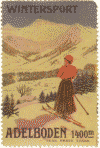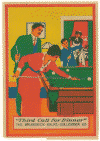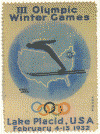Menu
What are Poster Stamps?
“What are those beautiful stamps?” I’m often asked by people who have never seen them.

As is often the case, opinions vary. I say “opinion” advisedly because there is no dictionary definition. The term arose to fill a need and that need varies with its user. Thus, one person’s poster stamp is another’s label or Cinderella (the term given by philatelists to anything that looks like a normal postage stamp but isn’t) or “album weed” or, more recently, the more knowledgeable collector's treasure.
The main purpose of poster stamps was to advertise products or events, promote political causes or good works, encourage tourism and so forth. They were affixed to envelopes and invoices; they were given away with products and they were collected to obtain other awards. The largest companies, like Chocolate Tobler and Nestle were able to issue their own poster stamp albums. Others commissioned designers and printers to prepare poster stamps especially for them. Smaller clients could select from thousands of stock designs and have their imprint placed upon them. Even philatelic dealers used them.

The main characteristic of the true poster stamp is integrity of design. After all, they were originally miniaturizations of full-sized posters. The poster stamp was created, often by the finest graphic artists of their time, with careful consideration of illustration, typography and color to maximize effectiveness. This was critical if the poster stamp was to serve its purpose to draw the eye and thus to promote the product or exhibition or idea it was designed to promote. This impact was often the result of the unusual use of colour or caricature or humour or elegance - something to make the image memorable. Such artistic excellence sets the poster stamp apart from its cousins, the letter seal, the label or the charity stamp, whose designs tend to be formulaic and mundane.
Charles M Price, a noted chronicler of the poster scene early in the 20th Century, felt the same and said this about the poster stamp: “It must have a clear simplicity of motive and a vigorous yet sometimes bizarre conception in design and treatment; it must first catch the eye, and having caught it, hold the gaze and incite further though brief inspection The advertisement which is the reason for its existence must be conveyed directly, clearly and pictorially; it must be well designed, well colored, well printed and well drawn - and these qualifications are stated in the order of their importance. Above all, the design - chic, bizarre an inspiration - a flash of thought in the brain pan, flaring up in a blaze of line and color, however short lived; it should be pyrotechnic and should depend for its impression, like a rocket, upon the rushing flight of its motion, and the brilliant, even if momentary, surprise of its explosion.”

Poster stamps have a long and interesting history. They began to appear during the late 19th century, although there are a few earlier examples. In those early years, especially in Europe and the US, poster stamps were used primarily to advertise exhibitions. The “bible” for early exhibition poster stamps is the 1914 Cazin and Rochas Timbres Commemoratifs catalogue. In this catalogue the earliest recorded poster stamp is 1845. The “Golden Age” was from 1900 to 1914. The Paris Exposition of 1900 resulted in an explosion of poster stamps. By 1913, it is estimated that as many as 50,000 different designs were produced in Germany alone. World War I ended this era and, whilst poster stamps continue to be produced to this day, their importance has waned with the availability of other advertising media.
But most important now: their significance and popularity is very much
on the rise again.
